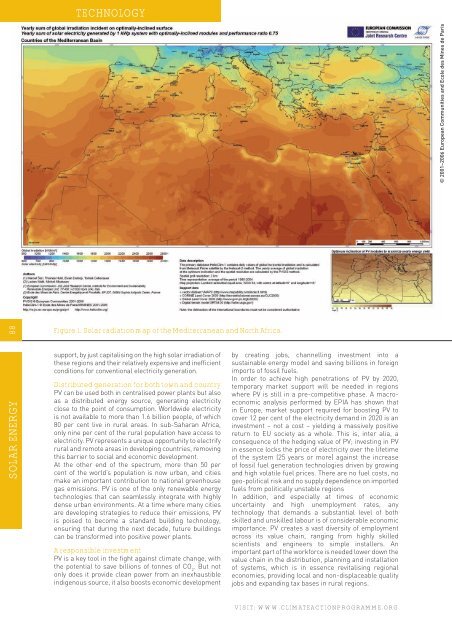Climate Action 2009-2010
Create successful ePaper yourself
Turn your PDF publications into a flip-book with our unique Google optimized e-Paper software.
TECHNOLOGY<br />
SOLAR ENERGY 88<br />
© 2001–2006 European Communities and Ecole des Mines de Paris<br />
Figure 1. Solar radiation map of the Mediterranean and North Africa.<br />
support, by just capitalising on the high solar irradiation of<br />
these regions and their relatively expensive and inefficient<br />
conditions for conventional electricity generation.<br />
Distributed generation for both town and country<br />
PV can be used both in centralised power plants but also<br />
as a distributed energy source, generating electricity<br />
close to the point of consumption. Worldwide electricity<br />
is not available to more than 1.6 billion people, of which<br />
80 per cent live in rural areas. In sub-Saharan Africa,<br />
only nine per cent of the rural population have access to<br />
electricity. PV represents a unique opportunity to electrify<br />
rural and remote areas in developing countries, removing<br />
this barrier to social and economic development.<br />
At the other end of the spectrum, more than 50 per<br />
cent of the world’s population is now urban, and cities<br />
make an important contribution to national greenhouse<br />
gas emissions. PV is one of the only renewable energy<br />
technologies that can seamlessly integrate with highly<br />
dense urban environments. At a time where many cities<br />
are developing strategies to reduce their emissions, PV<br />
is poised to become a standard building technology,<br />
ensuring that during the next decade, future buildings<br />
can be transformed into positive power plants.<br />
A responsible investment<br />
PV is a key tool in the fight against climate change, with<br />
the potential to save billions of tonnes of CO 2<br />
. But not<br />
only does it provide clean power from an inexhaustible<br />
indigenous source, it also boosts economic development<br />
by creating jobs, channelling investment into a<br />
sustainable energy model and saving billions in foreign<br />
imports of fossil fuels.<br />
In order to achieve high penetrations of PV by 2020,<br />
temporary market support will be needed in regions<br />
where PV is still in a pre-competitive phase. A macroeconomic<br />
analysis performed by EPIA has shown that<br />
in Europe, market support required for boosting PV to<br />
cover 12 per cent of the electricity demand in 2020 is an<br />
investment – not a cost – yielding a massively positive<br />
return to EU society as a whole. This is, inter alia, a<br />
consequence of the hedging value of PV; investing in PV<br />
in essence locks the price of electricity over the lifetime<br />
of the system (25 years or more) against the increase<br />
of fossil fuel generation technologies driven by growing<br />
and high volatile fuel prices. There are no fuel costs, no<br />
geo-political risk and no supply dependence on imported<br />
fuels from politically unstable regions<br />
In addition, and especially at times of economic<br />
uncertainty and high unemployment rates, any<br />
technology that demands a substantial level of both<br />
skilled and unskilled labour is of considerable economic<br />
importance. PV creates a vast diversity of employment<br />
across its value chain, ranging from highly skilled<br />
scientists and engineers to simple installers. An<br />
important part of the workforce is needed lower down the<br />
value chain in the distribution, planning and installation<br />
of systems, which is in essence revitalising regional<br />
economies, providing local and non-displaceable quality<br />
jobs and expanding tax bases in rural regions.<br />
VISIT: WWW.CLIMATEACTIONPROGRAMME.ORG












